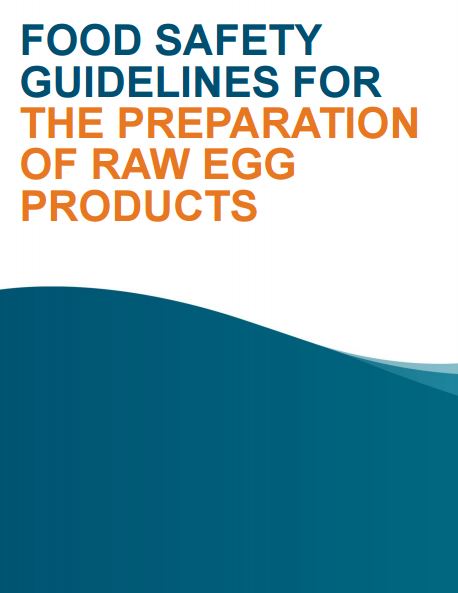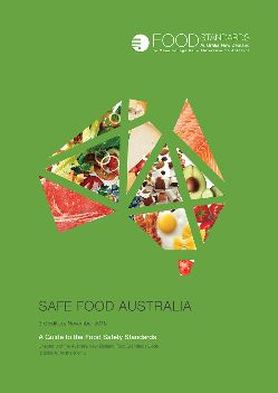Here is a copy of Codex HACCP (2023 version)
2023 Version
For use in all HACCP training and Auditing food safety training.
Download this file for use in training or workplace.
| codex_haccp_2023.pdf |
| ✓ Correct Training Systems |
|
Here is a copy of Codex HACCP (2023 version)General Principles of Food Hygiene. Codex Alimentarius Code of Practice, No.CXC 1-1969. 2023 Version For use in all HACCP training and Auditing food safety training. Download this file for use in training or workplace.
CTS has a list of food safety controls used and the validated reference source of the controls
NSW Food Authority have templates that businesses - Category 1 may use to record evidence of compliance to FSANZ 3.2.2A. Businesses may choose to use these forms or the ones provided by FSANZ as their forms, or their own version of a form or procedure - for a record of compliance. NSW Food Authority Forms
They can be found as Appendix 8 of Safe Food Australia. Available as a word document here.
NSW Food Authority has published a guideline that assist with safety parameters around cooling large portions of meat. The guideline presents information based on The Australian Standard AS4696-2007 Hygienic production and transportation of meat and meat products for human consumption. There are four options for cooling meat and poultry products that limit growth of C. perfringens to less than 1 log and allow no multiplication of C. botulinum in large portions of meat.:
NSW Food Authority have released a new version of the guidance document for Sous Vide. May 2022. Technical advice and tables for sous vide cookery
All GFSI and HACCP programs now require the business to build a positive food safety culture at work by developing awareness, empowerment and commitment to food safety.
There is a 2 minute free online U Tube video introducing the topic of "What is Food Safety Culture", produced by Safe Food Production QLD. It may be a useful introduction to staff to start discussion about the importance of building a positive Food Safety Culture. Codex Alimentarius The General Principles of Food Hygiene CXC 1- 1969 has been updated in late 2020. Changes include:
Correct Food Systems will be working with our clients to make any required adjustment to HACCP plans. We will be allowing adequate time for businesses make the necessary changes to their HACCP plans. Download Codex HACCP 2020 below. Register now for a Update - HACCP Refresher 2020 trainng
See our Utube interview with Gary Kennedy explaining this change.
Watch our short interview for an overview of the changes. Late February 2021 the FSANZ Code was amended to introduce new requirements for the labelling of allergens in food, sold in Australia. FSANZ approved Proposal P1044 Plain English Allergen Labelling (PEAL). Businesses have 3 years (till 25 February 2024) to adjust their product information and labels to meet the new requirements. There is a further 2 years stock in trade period. These requirements change how allergen information is to be declared. Products for sale in Australia will have specific allergen information, in a specific format, specific wording and terms, in bold font, in a specific location on food labels. PEAL changes include
See the Plain English Allergen Labelling webpage at Correct Food Systems Further information can be found at FSANZ in Standard 1.2.3 ( link to Standard 1.2.3), and Schedule 9 Mandatory Advisory Statements (link to Schedule 9) and in the proposal approval report.
FSANZ Food Standards Code 3.2.2.
Food Standards Practices and general requirements The NSW Food Authority has updated the learning resource for Allergen Management, that is to be taught as part of the Food Safety Supervisor training program, delivered by NSW Food Authority approved RTO's.
This updated resource encourages food safety supervisors to ensure food handlers who work in retail and food service businesses to know the 10 common allergens (including Lupin to be declared as a allergen form May 2018) and food intolerances, and be aware of business responsibilities regarding communicating allergen information in food for sale. Other key messages in this resource are:
.The NSW Food Authority has published a module of learning aimed to inform Food Safety Supervisors and businesses of their legal responsibilities, under the NSW Food Act 2003.
Key messages:
This also contains information on potential penalties ( fines) should a business or food handler be breach of the NSW Food Act 2003. Businesses, Food Safety Supervisors, or Managers should be aware of the application of the Food Safety Standards, the laws and regulations in their state or territory and the potential for fines, criminal convictions or even prison time. The Victorian Department of Health & Human Services Food Safety Unit has an excellent online learning resource (which was recently updated) called "DoFoodSafely". This hour long food safety program is free to use and covers the basic concepts and principles of food safety with recently updated content including more allergen specific information. It provides the underpinning knowledge of food safety that applies to safe food handling. The program includes seven topics on food safety and an assessment comprising of 30 multiple choice questions (this may increase over time). Participants who score more than 90 per cent in the assessment are awarded a certificate. The certificate of completion will have the users name on it, along with a date and certificate number. Participants will have to have an email address to receive the certificate. Please keep certificate in a safe place as a duplicate certificate will not be made available. Participants who complete the whole on-line course will be able to:
The link to the online food safety training is http://dofoodsafely.health.vic.gov.au/ Completion of this online training course and print out of the certificate are used as pre-reading and assessment of basic food safety knowledge in the Implement HACCP Food Safety Systems and Food Safety Supervisor training course. Instructions:
 The NSW Food Authority has released an updated version of the food safety guideline for the preparation of raw egg products. The NSW Food Authority has developed these guidelines to assist businesses to undertake practices that will ensure that they comply with requirements when making products known to cause salmonellosis. The guidelines advise businesses to use safe alternatives to raw eggs in foods which are not cooked. Alternatives include commercially produced dressings and sauces, or pasteurised egg products. Should businesses choose to use raw eggs in products, the guidelines advise suitable control steps for foods and menu items containing raw egg, known to cause cases of salmonellosis, that: -The raw egg product is to be acidified to a pH of 4.2 (or less) or effectively heat treated (giving businesses instructions on how to achieve this) -The treated raw egg product should be stored at or below 5˚C for no longer than 24 hours. Download this guideline at NSW Food Authority  This 3rd Edition, November 2016 updated reference provides guidance to the three food safety standards in Chapter 3 of the Australia New Zealand Food Standards Code (the Code). Businesses can use the guidance information to help them to comply with the standards. It also provides new guidance for mobile, temporary and home-based vendors, as well as generic food safety record templates. Down load the new version of Safe Food Australia The FSANZ website also launched a "Food Safety Hub", as a page that provides links to
Compendium updated in 2022 The Compendium of Microbiological Criteria for Food is a food industry resource, published by FSANZ. It is a microbiological guideline criteria used for ready-to-eat foods. It also provides microbiological criteria that can be used to verify hygiene measures or control of processing. It supersedes the Guidelines for the microbiological examination of ready-to-eat foods and User guide to Standard 1.6.1 - Microbiological Limits for Food with additional guidelines criteria. This compendium brings together information on:
Queensland Health has a excellent checklist for businesses to use to check their responsibilities under the Queensland Food Act and also the Food Standards Code. A useful checklist with suggested records for all businesses
Queensland Health have a excellent guide on the design and fitout of food premises, using information in Standard 3.2.3 and Australian Standard 4674-2004: Design, construction and fit-out of food premises. It aims to provide users seeking further information on how to comply with the requirements of the Standard with acceptable solutions on how they may meet the outcomes. The guide also provides some best practice options for those food businesses that choose to demonstrate a higher level of compliance.
The Australian Government has announced and released a new Standard for labelling food Country of Origin. This is effective from 1 July 2016, with a 2 year transition period. Download a copy of the new standard here.
CSIRO "Make it Safe" is an excellent text on food safety, providing a solid foundation of information about food safety, within Australia.
Order the text from CSIRO. http://www.publish.csiro.au/pid/6354.htm The NSW Food Authority has published a useful information brochure outlining how audits of food businesses in NSW work. This information guideline provides an explanation of the audit requirements for various food businesses, grading of audits. Table 5 lists key areas for various types of food businesses. Table 6 provides guidance on various aspects of audit compliance. if you operate a food business that is audited by the NSW Food Authority scheme this is well worth a review.
This guide provides an simple introduction into the principles of food safety. Although aimed at domestic consumers the information is sound and applicable to most food businesses. An excellent introduction to food safety. https://www2.health.vic.gov.au/about/publications/policiesandguidelines/Your%20Guide%20to%20Food%20Safety. Download the file here for pre reading to our Food Safety Supervisor Course or Implement HACCP Food Safety Systems training course.
Sous vide is a cooking method where food is cooked in sealed pouches or air tight plastic bags at exact - sometimes low - temperatures.The sous vide method is now used for many retail foods including ready meals for sale, some catered foods, and some items at restaurants.Businesses using sous vide must know how to manage the food safety risks that are associated with this method of cookery. To keep food safe:
Fact sheet from NSW Food Authority. This document is required reading for the CTS Audit a Cook Chill Process training program.
This guideline prepared by the NSW Food Authority explains the mandatory requirements detailed in current legislation and the Food Standards Code 3.3.1. It covers Licencing requirements that apply; Specific issues for a food safety program for a 3.3.1 licenced facility; Menu design; Preparation and Storage of ready to eat foods( not cooked); Cook Serve foods; Cook Chill foods; Preparation of texture modified and pureed foods; preparation of infant formula; Allergen control. It acts reference material for Cook Chill food preparation, HACCP and food safety programs, and auditing facilities that prepare and serve food to vulnerable populations. This document is recommended reading for the CTS Audit a Cook Chill Process training program.
The Allergen Bureau has published a PDF of a presentation on Allergen Fundamentals.
This resource can be downloaded from the Allergen Bureau here. This free resource is provided by the Allergen Bureau for:
|
Categories/
|
||||||||||||||||||||||||||||||||||||||||||||||||||||||||||||||||||||||||||||||||||||||||||||||||||||||||
Correct Food Systems-
|
|